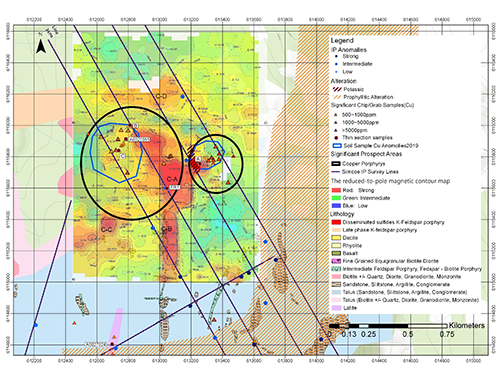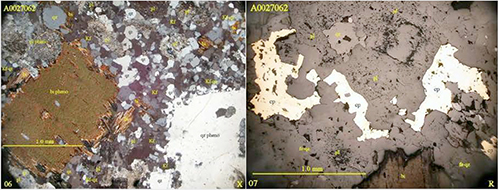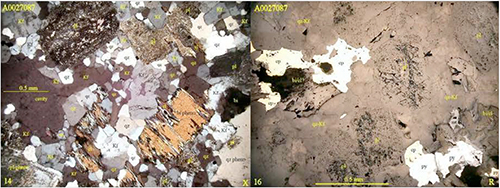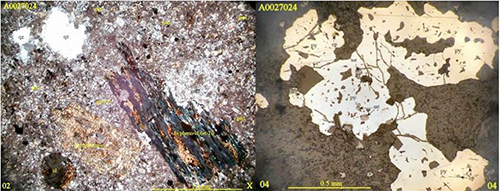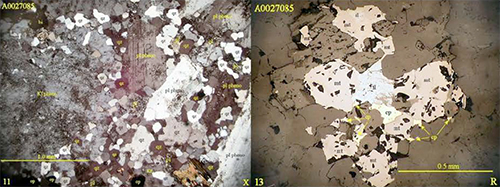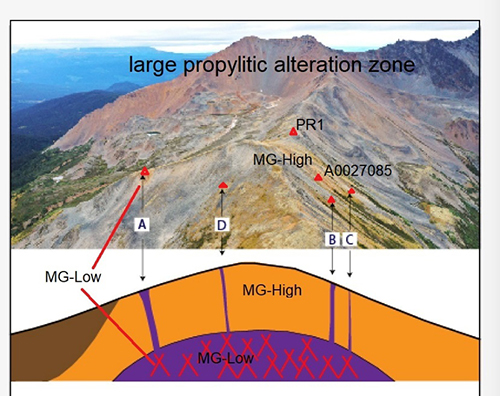Jaxon Reports Petrographic Study Results from Red Springs and Confirms Discovery of Disseminated Chalcopyrite-Bearing Granodiorite Porphyry Mineralization
December 17, 2019, Vancouver, Canada - Jaxon Mining Inc. ("Jaxon" or the "Company") (TSX.V: JAX, FSE: OU31, OTC: JXMNF) is pleased to announce the results of a petrographic study of the Red Springs Project conducted by John G. Payne, Ph.D., P.Geo. of Surrey, British Columbia, Canada. The study confirms Jaxon's discovery of a disseminated chalcopyrite-bearing biotite granodiorite porphyry mineralized system.
The Company's geologists discovered three K-feldspar porphyritic intrusion outcrops and collected rock samples from the outcrops at the Red Springs area during the 2019 phase 2 field work program (Figure 1, Table 1). Assay results for the samples were released December 12, 2019 (https://www.jaxonmining.com/news/2019/jaxon-reports-preliminary-ground-magnetic-survey-results-from-red-springs-and-assay-results-for-k-feldspar-porphyry-outcrop). The full petrographic study can be viewed at https://jaxonmining.com/projects/red-spring/petrographic-study/.
Figure 1: Comprehensive map of magnetic/IP and Cu in soil anomalies and porphyritic rock outcrop sample locations and mineralization at the Red Springs Project
Table 1: Sample Details from Petrographic Study Report
Sample ID | Sample | Rock Types | Cu Assay | Major Sulfides | Major |
A0027024 | Primary Ridge South, | Hypabyssal | 854 | Magnetite 1-2% | Quartz- |
A0027062 | Outcrop A, | Porphyritic biotite | 1549 | Chalcopyrite 1-2% | K-feldspar- |
A0027077 | Outcrop C | Hypabyssal | 802 | Pyrite 1-1.5% | Sericite- |
A0027085 | Primary Ridge West | Hypabyssal | 507 | Magnetite 1-2% | Chlorite- |
A0027087 | Outcrop B | Hypabyssal | 909 | Pyrite 0.3% | K-feldspar- |
PR1 | Primary Ridge East | Hypabyssal | NA | Magnetite 1-2% | Chlorite- |
Highlights of Petrographic Study for K-feldspar Porphyry Outcrop Samples at the Red Springs Project
- Sample A0027062 from outcrop A area is identified as a porphyritic biotite granodiorite and shows altered potassic feldspar-sericite-chlorite porphyritic granodiorite characters with 1-2% disseminated chalcopyrite (Figure 2). It coincides with a magnetic low feature, medium IP chargeability anomaly and surface potassic alteration, high Cu in soil anomaly (Figure 1). It is the best copper porphyry mineralization target defined currently at the Red Springs project.
- Sample A0027077 and A0027087 from outcrops B and C areas are considered as intrusion dykes from deep magma chamber and are identified as the hypabyssal porphyritic biotite granodiorite which shows mainly sericite-chlorite and weak potassic alteration with 0.2% disseminated chalcopyrite (Figure 3). These two samples are also located in a magnetic low and strong Cu soil anomaly area (Figure 1). They present potential copper porphyry mineralization targets at Red Springs.
- Sample A0027024 from the Primary Ridge southwest slope area is identified as a hypabyssal porphyritic quartz-bearing latite which shows quartz-chlorite-sericite-calcite alteration and 1-2 % magnetite and 1-2% pyrite and trace chalcopyrite (Figure 4). It is an early phase magnetic high latite and is considered to be part of a phyllic alteration zone and next to the distal, large scale, semi-circular, surface rusted, greater than 1 km wide and 4 km long propylitic alteration zone at the Red Springs project area (Figure 1).
- Sample A0027085 and PR1 from the Primary Ridge top area are identified as hypabyssal porphyritic (hornblende)-biotite granodiorite which shows biotite-chlorite-sericite alteration with 1-2% magnetite and trace chalcopyrite (Figure 5). It is an early phase magnetic high granodiorite and is also considered to be part of a phyllic alteration zone and next to/within the centre potassic alteration and porphyry mineralization at the Red Springs project area (Figure 1).
- The petrographic study confirms the Company's discovery of the disseminated chalcopyrite-bearing, magnetite porphyritic biotite granodiorite mineralization system on the surface at the Red Springs project. The Company's conceptual geological model depicts a large system of the same type with higher copper grade porphyritic biotite granodiorite mineralisation laying beneath the magnetic high granodiorite rocks. The model interprets the outcrops of these disseminated sulfide, K-feldspar-sericite-chlorite-quartz-calcite (altered), vein stockwork granodiorite porphyry intrusions (dyke) as fringes emanating from the large porphyry intrusion below (Figure 6).
Figure 2: Thin Section Photos of Sample A0027062, Left, phenocryst of biotite, quartz and small plagioclase phenocrysts (altered to sericite) in a groundmass of K-feldspar and quartz with anhedral plagioclase (altered to sericite) and accessory biotite; Right, patches of chalcopyrite intergrown with feldspars and quartz, near a grain of biotite.
Figure 3: Thin Section Photos of Sample A0027087, Left, phenocrysts of quartz, K-feldspar (with inclusions of "groundmass" quartz near its margin) and of plagioclase (altered to sericite and dusty semi-opaque), two small phenocrysts(?) of biotite (altered to chlorite) in a groundmass of K-feldspar, quartz, and minor plagioclase (altered moderately to sericite); right, a cluster of chalcopyrite (with biotite/chlorite?) and a cluster of pyrite with lesser chalcopyrite and magnetite (also with biotite/chlorite); subhedral plagioclase grains (altered slightly to moderately to sericite and dusty semi-opaque) with patches of quartz-K-feldspar.
Figure 4: Thin Section Photos of Sample A0027024, Left, biotite phenocryst (altered completely to pseudomorphic chlorite and lenses of calcite and Ti-oxide/ilmenite), plagioclase phenocryst (altered strongly to sericite-calcite); groundmass is mainly gm1 (plagioclase-K-feldspar with minor magnetite and chlorite) with a local patch of a finer grained variation (gm1f); patch of gm2 dominated by plagioclase; two patches of quartz, the larger one probably is a phenocryst with an overgrowth of later quartz; small round patch of chlorite-(calcite) of uncertain origin, Right, cluster of anhedral pyrite grains with inclusions of silicates, of magnetite, and minor ones of chalcopyrite.
Figure 5: Thin Section Photos of Sample A0027085, left, phenocrysts of plagioclase and of quartz; finer grained plagioclase (commonly altered moderately to sericite and dusty semi-opaque), groundmass of quartz, K-feldspar, and plagioclase, a few grains of biotite (fresh to altered completely to chlorite); Right, cluster of magnetite, lesser ilmenite (altered moderately to leucoxene) and chalcopyrite surrounded by feldspars, quartz, and biotite/hornblende(?).
Figure 6: Proposed preliminary 3D mineralization model of the Red Springs Porphyry Project. A, B and C, outcrops of K-feldspar granodiorite porphyry intrusion with disseminated chalcopyrite, D, float of K-feldspar granodiorite porphyry intrusion with disseminated chalcopyrite; PR1 and A0027085, thin section samples
Mr. John King Burns, CEO and Chairman of the Board commented, "The Company wishes to thank Dr. Payne for his petrographic report. This study is part of Jaxon's systematic approach to exploration in advance of further drilling. The petrologic results, together with the geological mapping, soil geochemistry and magnetic survey results, already in hand, all support the Company's conceptual geological model which depicts the existence of a large copper porphyry mineralisation system at Red Springs. This system displays the alteration-mineralization zoning pattern for porphyry Cu systems as described by Richard H. Sillitoe, "Porphyry Copper Systems" (2010) and is specially demarked by the occurrence of anomalously high copper in soil results from our 2019 geochemical surveys. The petrographic study results have been integrated into our evolving model which the Company will use to develop informed drill targets for 2020. Our geotechnical data sets now support each other, however, additional selective field work will be conducted in 2020 to refine and test the data. Next year is shaping up to be a very exciting year for the Company and its stakeholders."
Sample Preparation and Analyses
All samples described in this news release were collected by the Company's Qualified Professional Geologists. The thin sections of all the samples were prepared by Vancouver GeoTech Labs of Unit #155 - 11951 Mitchell Road, Richmond, BC, Canada. The thin sections were described by PhD and Professional Geoscientist, John Payne of Surrey, BC, Canada.
Chip and prospecting samples were collected in the field by experienced, professional prospectors and geological staff who selected hand samples from outcrop, chip samples, boulder and talus debris samples suitable for slabbing by rock saw. The samples were numbered, described and located in the field for follow-up. Numbered rock samples tags were placed inside each bag, securely closed for transport to the Company's secure cold storage locked facility in Smithers, B.C. Representative sample slabs were cut from large specimens and halved rock samples so that portions of select samples could be saved for the Company's rock library, descriptive purposes and petrographic study. MS Analytical of Langley, B.C. received the Rice Bag shipments after secure transport from Smithers. Samples were prepared by crushing, grinding and pulverizing to a pulp with barren material washing between each sample at the crush and pulverizing stages. Then 20 g of pulp was used for the (IMS-117 code) ultra-trace level ICP/MS AR digestion method, and four acid 0.2 g ore grade ICP – AES method (ICP-240) and for the overlimit gold the FAS-415 method of 30 g fusion Gravimetric method was used to report gold ASSAYS. Overlimit silver is determined by Fire ASSAY 415 method. Laboratory standards and QA – QC is monitored by the Company.
Qualified Person
Yingting (Tony) Guo, P.Geo., President and Chief Geologist for Jaxon Mining Inc., a Qualified Person as defined by National Instrument 43-101, has reviewed and prepared the scientific and technical information and verified the data supporting such scientific and technical information contained in this news release.
About Jaxon Mining Inc.
Jaxon is a precious and base metals exploration company with a regional focus on Western Canada. The Company is currently focused on advancing its Red Springs Project in north-central British Columbia.
ON BEHALF OF THE BOARD OF DIRECTORS
JAXON MINING INC.
"John King Burns"
John King Burns, Chairman
For more information please contact:
Investor Relations
Kaye Wynn Consulting
T: 604-558-2630
TF: 1-888-280-8128
E: info@kayewynn.com
Freeform Communications
T: 604-243-0499
E: enquiries@freeform.com
Corporate
T: 604-398-5394
E: info@jaxonmining.com
www.jaxonmining.com
This news release may contain forward-looking information, which is not comprised of historical facts. Forward-looking information involves risks, uncertainties and other factors that could cause actual events, results, performance, prospects and opportunities to differ materially from those expressed or implied by such forward-looking information. Forward-looking information in this news release may include, but is not limited to, the Company's objectives, goals or future plans. Factors that could cause actual results to differ materially from such forward-looking information include, but are not limited to, those risks set out in the Company's public documents filed on SEDAR. Although the Company believes that the assumptions and factors used in preparing the forward-looking information in this news release are reasonable, undue reliance should not be placed on such information, which only applies as of the date of this news release, and no assurance can be given that such events will occur in the disclosed time frames, or at all. The Company disclaims any intention or obligation to update or revise any forward-looking information, whether as a result of new information, future events or otherwise, other than as required by law. Neither TSX Venture exchange nor its Regulations Services Provider (as that term is defined in the policies of the TSX Venture Exchange) accepts responsibility for the adequacy or accuracy of this release.

